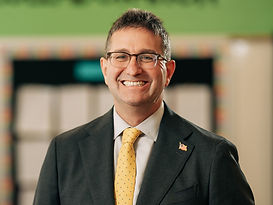GUEST COLUMN.
HOW CAN LOCAL GOVERNMENTS IMPROVE HEALTH FOR OLDER AMERICANS?
By Tony Mazzucco, general manager, Norwood, Massachusetts

During the Baby Boom era, schools were built at an unprecedented rate to meet the needs of a burgeoning population of young people—many of these schools are still in use today. Now, as society seeks out ways to improve the health of older Americans, we face a similar situation, but at the other end of the age spectrum.
Unfortunately, not enough is being done yet – though the opportunities are clear; notably in helping to provide transportation for people who are unable to get around in their own vehicles.
Take Norwood, Massachusetts, a suburb 10 miles outside of Boston. When the pandemic caused the loss of traditional cab services, the town sought to solve this seemingly simple transportation issue with no cost supplementary transit for seniors. We didn't anticipate the sheer number of routine healthcare appointments, dental, eye care, physical therapy—that were being skipped due to transportation challenges. For many seniors, the cost of transportation was prohibitive, or they didn’t want to impose on family members for appointments they deemed non-essential.
In fact, according to the community’s surveys, at least 20% of the medical appointments we transport seniors to would not have occurred without our services. With an average of 1,800 trips per year, that equates to over 350 medical appointments for seniors in our community that otherwise would have been missed. When considering that seniors answered this survey question in varying ways—20% being the lower end—the figure could be as high as 50%.
A Low-Cost, High-Impact Solution
Norwood’s program depends on part-time and per-diem drivers, many of them seniors themselves, who keep operational costs low. These drivers often find the work gratifying, which has made recruitment relatively easy compared to other industries. The program is simple yet effective, utilizing three vehicles operating nearly full-time to complete approximately 1,800 rides annually. The total cost, including vehicle acquisition, driver wages, fuel, and maintenance, remains remarkably affordable. Moreover, the program is ripe for grant funding opportunities, as its narrative is compelling and its impact easily measurable through data such as the number of rides provided.
In the future, the program plans to expand its funding sources by reaching out to local businesses. For example, healthcare providers who benefit directly from seniors attending their appointments may be willing to contribute to the program. What doctor wouldn’t want to support a system that ensures elderly patients can consistently access care? While grant and general fund supported at this time, the program is certainly ripe for significant donations.
Supporting Families and Strengthening Communities
Older Americans overwhelmingly prefer to remain in their homes. Arguments that they should vacate their homes for younger generations to improve housing affordability are both economically impractical and socially disruptive. A housing shortage cannot be resolved simply by moving people around. Instead, inclusive solutions that address the needs of all community members are essential.
What’s more, the benefits of programs like this one extend beyond seniors themselves. Reliable transportation for elderly residents alleviates burdens on working families, for example, especially those in the so-called "sandwich generation," who are often tasked with caring for both children and aging parents. It's not a matter of love or dedication—there are simply only so many hours in the day. Enabling older people to live independently in their homes while ensuring safe, reliable access to medical appointments reduces stress on families and improves overall quality of life.
Looking Ahead: Expanding Services and Opportunities
Measuring health outcomes can be challenging, but programs like this clearly show the value of accessible transportation for seniors. Norwood's program continues to grow, with plans to extend service into Boston and introduce companion services for seniors who require assistance before and after medical procedures. For example, an 80-year-old living alone might need someone to accompany them after a surgery involving anesthesia, especially if their family lives hours away.
Additionally, the town is exploring programs for individuals with intellectual disabilities, aiming to provide transportation not only to medical appointments but also to work opportunities. These efforts underscore a larger truth: supporting seniors isn’t just compassionate—it’s also economically beneficial.
Conclusion: A Model Worth Replicating
Norwood’s transportation program is a shining example of how simple, cost-effective solutions can address significant societal challenges. By ensuring seniors can access vital healthcare services, the program enhances individual health outcomes, supports families, and strengthens community bonds. As we move forward, let this serve as a model for how other communities can embrace the "Elder Boom" with dignity, compassion, and innovation. Taking care of our seniors is not only the right thing to do—it’s also good for society as a whole.
The contents of this Guest Column are those of the author, and not necessarily Barrett and Greene, Inc.
#StateandLocalGovernmentManagement #StateandLocalGovernmentPerformance #StateandLocalGovernmentInnovation #SuburbanTransportationManagement #TransportationInnovation #CarServiceInnovation #LocalTransportationManagement #LocalServicesForSeniors #NorwoodMA #InnovationForOlderAmericans #TransportationForElderlyResidents #HomeHealthCare #PostPandemicTaxiLoss #NorwoodFreeTransportationService #MissedMedicalAppointments #ManagingTransportationForOlderAmerians #GeneralManagerTonyMazzuco #BandGGuestColumn #BarrettandGreemeInc



































































































